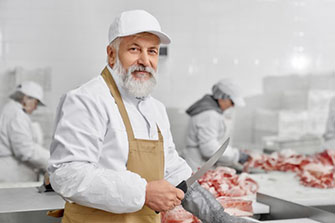An official website of the United States government
 United States Department of Labor
United States Department of Labor

Cut, trim, or prepare consumer-sized portions of meat for use or sale in retail establishments.
The qualifications that workers need to use judgment, make decisions, interact with others, and adapt to changes in jobs.
In 2024, more than basic people skills were required for less than 5 percent of butchers and meat cutters, and basic people skills were required for greater than 95 percent.
| Requirement | Yes | No |
|---|---|---|
|
Adaptability: Work schedule variability |
53.7 | 46.3 |
|
Pace: Pause control |
8.1 | 91.9 |
|
Working around crowds |
<0.5 | >99.5 |
|
Telework |
<0.5 | >99.5 |
|
Work review: Supervising others |
<0.5 | >99.5 |
|
Work review: Presence of supervisor |
>85 | <15 |
|
Source: U.S. Bureau of Labor Statistics, Occupational Requirements Survey |
||
The minimum level of formal education required, credentials necessary, on-the-job training, and prior work experience necessary for average performance in jobs.
In 2024, prior work experience was required for 21.1 percent of butchers and meat cutters and on-the-job training was required for greater than 80 percent.
No minimum education was required for 66.5 percent of butchers and meat cutters.
The various tangible or concrete hazards or difficulties that are in the vicinity of where jobs’ critical tasks are performed.
Refer to the physical activities required to perform tasks in jobs. The presence and, in some cases, duration of these activities are published.
In 2024, reaching at or below the shoulder was required for greater than 99.5 percent of butchers and meat cutters and was not required for less than 0.5 percent. For 57.3 percent of workers, reaching at or below the shoulder was occasionally performed, 14.3 percent frequently, and for less than 0.5 percent reaching at or below the shoulder occurred constantly.
Performing work in low postures was required for 91.9 percent of butchers and meat cutters and was not required for 8.1 percent.
On average, butchers and meat cutters spent 99.6 percent of the workday standing.
| Requirement | Yes | No |
|---|---|---|
|
Choice of sitting or standing |
<0.5 | >99.5 |
|
Driving |
<0.5 | >99.5 |
|
Climbing structure-related ramps or stairs |
<0.5 | >99.5 |
|
Source: U.S. Bureau of Labor Statistics, Occupational Requirements Survey |
||